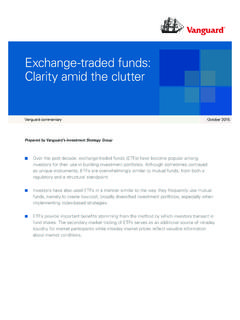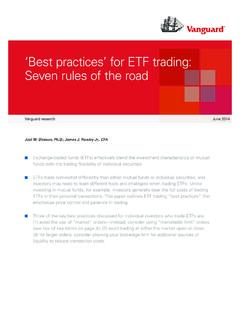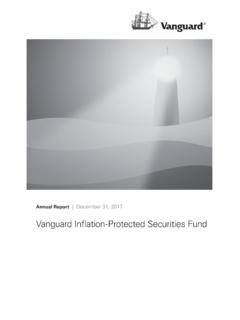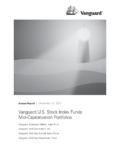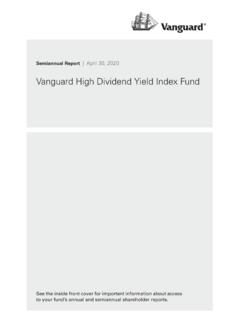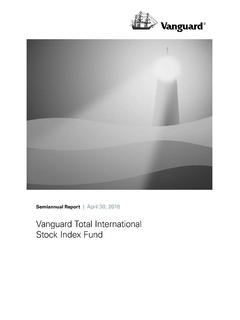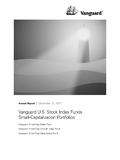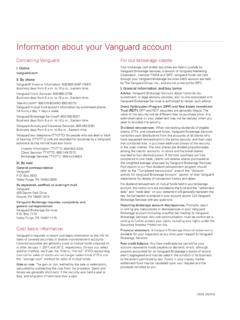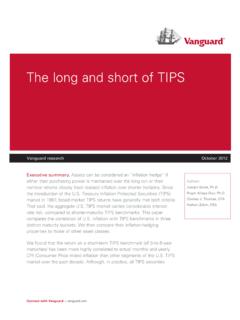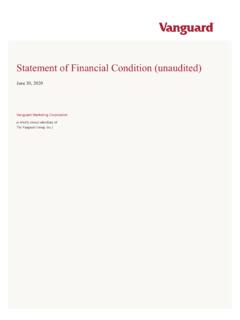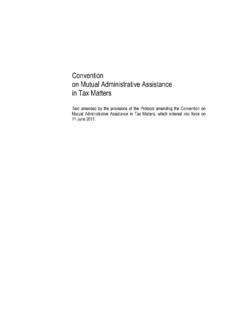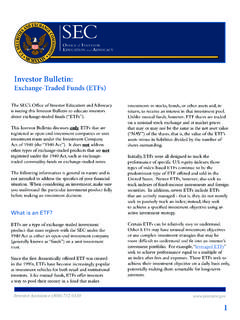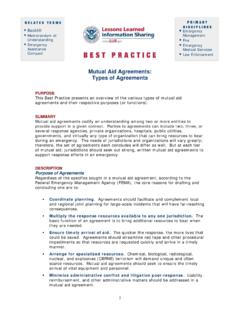Transcription of Choosing between ETFs and mutual funds: Strategy, then ...
1 The buck stops here: Vanguard money market fundsChoosing between etfs and mutual funds: Strategy, then structure Joel M. Dickson, ; David T. Kwon, CFA; James J. Rowley Jr., CFAV anguard Research September 2015 An investor s decision to use an exchange-traded fund (ETF) versus a conventional mutual fund is a portfolio-implementation decision, rather than a choice of investment strategy. In terms of product structure, etfs are more similar to mutual funds than they are different. Both vehicles offer the benefits of pooled investing, primary regulation under the same laws, and an ability to issue new shares and redeem existing shares that allows investors to transact at a fair price.
2 Four key factors should be considered when deciding between using etfs and mutual funds: investment strategy, trading flexibility, accessibility, and costs. For investors who prefer a greater variety of index-based strategies, the ability to trade intraday with various order types, and more open fund access, etfs may be the better choice. However, for investors who want a greater variety of traditional actively managed strategies, the trading convenience of mutual funds, and the breadth of mutual funds available on their trading platform, mutual funds may be preferable. Costs are a function of both ongoing costs and transaction costs, and may depend largely on the time horizon of the investment.
3 1 Unless otherwise stated, all data points in this paper are derived from Vanguard calculations using Morningstar, Inc., as of June 30, 2015. The data include mutual funds (open-end funds) and what are sometimes referred to as exchange-traded products such as open-end etfs , unit investment trust etfs , grantor-trust etfs , and partnership etfs . We have excluded exchange-traded notes (ETNs) from this universe of exchange-traded products, as well as from the text discussion here, because ETNs actually are debt instruments and not true investment funds. 2 See Brinson, Hood, and Beebower (1986), for further discussion of asset See Donaldson et al. (2013), for further discussion of top-down portfolio funds and exchange-traded funds ( etfs ) have become popular options for investors around the world.
4 As of June 30, 2015, total ETF assets stood at $ trillion globally, representing 11% of overall fund assets. In the United States, etfs have recently grown at a more rapid pace than mutual funds. For the ten years ended June 30, ETF assets expanded at an annual rate of 24%, to $ trillion increasing from just 4% to 14% of overall fund assets. Today, investors can select from more than 1,500 etfs and close to 8,000 mutual funds in the United States This paper focuses on helping investors make an informed decision between mutual funds and etfs as product vehicles. We reiterate that although the product-vehicle decision is clearly important, research has shown that the asset allocation decision is the crucial determinant of portfolio performance, since it explains the vast majority of the variability of investors returns2 and is the starting point for the portfolio-construction between mutual funds and etfs mutual funds and etfs share many key characteristics.
5 Both are pooled vehicles that provide exposure to various markets, diversification, and generally reasonable investment costs; they are primarily regulated by the same laws; and they issue new shares and redeem existing shares to meet investor demand. Both structures have conveniently enabled investors to implement asset allocation decisions when building diversified investment portfolios. Figure 1 shows how similarly mutual fund and ETF investors have allocated assets across broad categories. As of June 30, 2015, 96% of ETF assets were invested in etfs organized and regulated as registered investment companies under the Investment Company Act of 1940 (1940 Act), the same regulatory regime that governs mutual funds.
6 The 1940 Act provides for a host of investor protections, including requiring a fund to hold at least 85% of its net assets in liquid assets, constraining 2 Notes about risk and performance data: Investments are subject to market risk, including the possible loss of the money you invest. Past performance is no guarantee of future returns. Be aware that fluctuations in the financial markets and other factors may cause declines in the value of your account. There is no guarantee that any particular asset allocation or mix of funds will meet your investment objectives or provide you with a given level of income. We recommend that you consult a tax or financial advisor about your individual situation.
7 Funds that concentrate on a relatively narrow market sector face the risk of higher share-price volatility. Prices of mid- and small-cap stocks often fluctuate more than those of large-company stocks. government backing of Treasury or agency securities applies only to the underlying securities and does not prevent share-price fluctuations. Because high-yield bonds are considered speculative, investors should be prepared to assume a substantially greater level of credit risk than with other types of bonds. Diversification does not ensure a profit or protect against a loss in a declining market. 4 The SEC is the primary regulator of mutual funds and etfs subject to the 1940 Act.
8 Among other oversight functions, the SEC conducts both periodic and special examinations of funds compliance controls, operations, and compliance with regulatory fund s use of leverage, and mandating that a fund s assets be held by a custodian (typically a bank), but segregated from the asset manager and the bank s assets. To the extent the management firm or bank were to go bankrupt, ETF and mutual fund investors have a legal right to the fund s assets. In addition, all mutual funds and etfs must comply with the disclosure-based provisions of the 1940 Act, the Securities Act of 1933, and associated Securities Exchange Commission These provisions require etfs and mutual funds to disclose material information via fund prospectuses and annual reports to help investors make informed investment decisions.
9 Perceived differences: mutual funds and ETFsDifferences between mutual funds and etfs are often exaggerated by the investment community. For example, etfs are often promoted as costing significantly less than mutual funds. On its face, such a claim appears to be true, since etfs have an expense-ratio advantage relative to mutual funds both in terms of a simple cost average ( versus , respectively) and an asset-weighted cost average ( versus ). However, this advantage is due largely to the investment strategy of most etfs , rather than to their product structure. Ninety-nine percent of ETF assets as of June 30, 2015, were index-based, while 84% of mutual fund assets were actively managed.
10 Given that expense ratios of index vehicles tend to be lower than those of actively managed strategies, Figure 2 confirms that etfs cost advantage has more to do with whether or not the underlying strategy is indexed rather than whether the structure is an ETF or mutual fund . 3 Figure 1. mutual fund and ETF investors display similar allocationsNotes: Asset classes are represented by Morningstar s Category Group designation. Data reflect funds that existed as of June 30, : Vanguard calculations, based on data from Morningstar Direct. mutual fund assetsETF assets42%16%22%5%15% equityInternational equityTaxable bondMunicipal bondOther42%22%15%1%20% equityInternational equityTaxable bondMunicipal bondOtherFigure 2.
